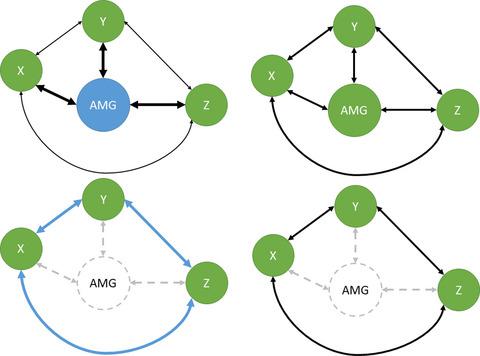当前位置:
X-MOL 学术
›
Eur. J. Neurosci.
›
论文详情
Our official English website, www.x-mol.net, welcomes your
feedback! (Note: you will need to create a separate account there.)
Network level characteristics in the emotion recognition network after unilateral temporal lobe surgery
European Journal of Neuroscience ( IF 2.7 ) Pub Date : 2020-06-03 , DOI: 10.1111/ejn.14849 Yun‐An Huang 1 , Patrick Dupont 2 , Laura Van de Vliet 1 , Jan Jastorff 1 , Ron Peeters 3 , Tom Theys 4 , Johannes Loon 4 , Wim Van Paesschen 5 , Jan Van den Stock 1, 6 , Mathieu Vandenbulcke 1, 6
European Journal of Neuroscience ( IF 2.7 ) Pub Date : 2020-06-03 , DOI: 10.1111/ejn.14849 Yun‐An Huang 1 , Patrick Dupont 2 , Laura Van de Vliet 1 , Jan Jastorff 1 , Ron Peeters 3 , Tom Theys 4 , Johannes Loon 4 , Wim Van Paesschen 5 , Jan Van den Stock 1, 6 , Mathieu Vandenbulcke 1, 6
Affiliation

|
The human amygdala is considered a key region for successful emotion recognition. We recently reported that temporal lobe surgery (TLS), including resection of the amygdala, does not affect emotion recognition performance (Journal of Neuroscience , 2018, 38 , 9263). In the present study, we investigate the neural basis of this preserved function at the network level. We use generalized psychophysiological interaction and graph theory indices to investigate network level characteristics of the emotion recognition network in TLS patients and healthy controls. Based on conflicting emotion processing theories, we anticipated two possible outcomes: a substantial increase of the non‐amygdalar connections of the emotion recognition network to compensate functionally for the loss of the amygdala, in line with basic emotion theory versus only minor changes in network level properties as predicted by psychological construction theory. We defined the emotion recognition network in the total sample and investigated group differences on five network level indices (i.e. characteristic path length, global efficiency, clustering coefficient, local efficiency and small‐worldness). The results did not reveal a significant increase in the left or right temporal lobectomy group (compared to the control group) in any of the graph measures, indicating that preserved behavioural emotion recognition in TLS is not associated with a massive connectivity increase between non‐amygdalar nodes at network level. We conclude that the emotion recognition network is robust and functionally able to compensate for structural damage without substantial global reorganization, in line with a psychological construction theory.
中文翻译:

单侧颞叶手术后情绪识别网络的网络水平特征
人杏仁核被认为是成功识别情绪的关键区域。我们最近报道说,颞叶手术(TLS),包括切除扁桃体,不影响情绪的识别性能(神经科学杂志,2018,38,9263)。在本研究中,我们在网络级别调查了此保留功能的神经基础。我们使用广义的心理生理交互作用和图论指标来调查TLS患者和健康对照者的情绪识别网络的网络水平特征。基于相互矛盾的情感处理理论,我们预期了两个可能的结果:情感识别网络的非杏仁体连接的显着增加,以在功能上补偿杏仁核的损失,这与基本的情感理论相符,而网络水平只有很小的变化心理建构理论预测的属性。我们在总样本中定义了情感识别网络,并研究了五个网络水平指标(即特征路径长度,全球效率,聚类系数,局部效率和小世界)。结果没有显示在任何图形测量中左或右颞叶切除术组(与对照组相比)有显着增加,表明TLS中保留的行为情感识别与非杏仁核之间的大量连接性增加无关网络级别的节点。我们得出的结论是,根据心理建构理论,情绪识别网络功能强大且功能强大,能够在不进行实质性全球重组的情况下补偿结构性损害。表示在TLS中保留的行为情感识别与网络级别的非杏仁体节点之间的大量连接性增加没有关联。我们得出的结论是,根据心理建构理论,情绪识别网络功能强大且功能强大,能够在不进行实质性全球重组的情况下补偿结构性损害。表示在TLS中保留的行为情感识别与网络级别的非杏仁体节点之间的大量连接性增加没有关联。我们得出的结论是,根据心理建构理论,情绪识别网络功能强大且功能强大,能够在不进行实质性全球重组的情况下补偿结构性损害。
更新日期:2020-07-03
中文翻译:

单侧颞叶手术后情绪识别网络的网络水平特征
人杏仁核被认为是成功识别情绪的关键区域。我们最近报道说,颞叶手术(TLS),包括切除扁桃体,不影响情绪的识别性能(神经科学杂志,2018,38,9263)。在本研究中,我们在网络级别调查了此保留功能的神经基础。我们使用广义的心理生理交互作用和图论指标来调查TLS患者和健康对照者的情绪识别网络的网络水平特征。基于相互矛盾的情感处理理论,我们预期了两个可能的结果:情感识别网络的非杏仁体连接的显着增加,以在功能上补偿杏仁核的损失,这与基本的情感理论相符,而网络水平只有很小的变化心理建构理论预测的属性。我们在总样本中定义了情感识别网络,并研究了五个网络水平指标(即特征路径长度,全球效率,聚类系数,局部效率和小世界)。结果没有显示在任何图形测量中左或右颞叶切除术组(与对照组相比)有显着增加,表明TLS中保留的行为情感识别与非杏仁核之间的大量连接性增加无关网络级别的节点。我们得出的结论是,根据心理建构理论,情绪识别网络功能强大且功能强大,能够在不进行实质性全球重组的情况下补偿结构性损害。表示在TLS中保留的行为情感识别与网络级别的非杏仁体节点之间的大量连接性增加没有关联。我们得出的结论是,根据心理建构理论,情绪识别网络功能强大且功能强大,能够在不进行实质性全球重组的情况下补偿结构性损害。表示在TLS中保留的行为情感识别与网络级别的非杏仁体节点之间的大量连接性增加没有关联。我们得出的结论是,根据心理建构理论,情绪识别网络功能强大且功能强大,能够在不进行实质性全球重组的情况下补偿结构性损害。











































 京公网安备 11010802027423号
京公网安备 11010802027423号